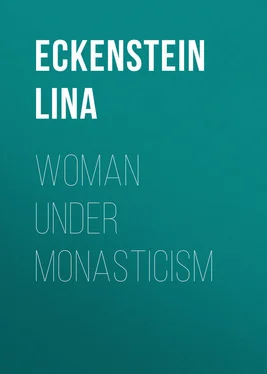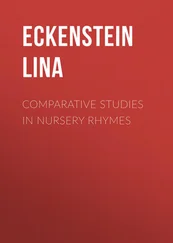Lina Eckenstein - Woman under Monasticism
Здесь есть возможность читать онлайн «Lina Eckenstein - Woman under Monasticism» — ознакомительный отрывок электронной книги совершенно бесплатно, а после прочтения отрывка купить полную версию. В некоторых случаях можно слушать аудио, скачать через торрент в формате fb2 и присутствует краткое содержание. Жанр: История, foreign_antique, foreign_prose, на английском языке. Описание произведения, (предисловие) а так же отзывы посетителей доступны на портале библиотеки ЛибКат.
- Название:Woman under Monasticism
- Автор:
- Жанр:
- Год:неизвестен
- ISBN:нет данных
- Рейтинг книги:4 / 5. Голосов: 1
-
Избранное:Добавить в избранное
- Отзывы:
-
Ваша оценка:
- 80
- 1
- 2
- 3
- 4
- 5
Woman under Monasticism: краткое содержание, описание и аннотация
Предлагаем к чтению аннотацию, описание, краткое содержание или предисловие (зависит от того, что написал сам автор книги «Woman under Monasticism»). Если вы не нашли необходимую информацию о книге — напишите в комментариях, мы постараемся отыскать её.
Woman under Monasticism — читать онлайн ознакомительный отрывок
Ниже представлен текст книги, разбитый по страницам. Система сохранения места последней прочитанной страницы, позволяет с удобством читать онлайн бесплатно книгу «Woman under Monasticism», без необходимости каждый раз заново искать на чём Вы остановились. Поставьте закладку, и сможете в любой момент перейти на страницу, на которой закончили чтение.
Интервал:
Закладка:
At the outset it lay with the local dignitary to recognise or reject the names which the folk held in veneration. Religious settlements and Church centres regulated days and seasons according to the calendar of the chief festivals of the year, as accepted by the Church at Rome; but the local dignitary was at liberty to add further names to the list at his discretion. For centuries there was no need of canonisation to elevate an individual to the rank of saint; the inscribing of his name on a local calendar was sufficient. Local calendars went on indefinitely swelling the list of saintly names till the Papal See felt called upon to interfere 24 24 On English calendars, Piper, F., Kalendarien und Martyrologien der Angelsachsen , 1862; Stanton, R., Menology of England and Wales , 1887.
. Since the year 1153 the right to declare a person a saint has lain altogether with the authorities at Rome 25 25 Stadler und Heim, Vollständiges Heiligenlexicon , 1858-62, vol. 2, Einleitung.
.
Considering the circumstances under which the peoples of German race first came into contact with Christianity, it is well to recall the fact that a busy Church life had grown up in many of the cities north of the Alps, which were centres of the Roman system of administration previous to the upheaval and migration of German heathen tribes, which began in the fourth century. Legend has preserved stories of the apostles and their disciples wandering northwards and founding early bishoprics along the Rhine, in Gaul and in Britain 26 26 For France, Guettée, Histoire de l’Église de France , 1847-55, vol. 1, p. 1; for England, Bright, W., Early English Church History , 1878, pp. 1 ff.; for Germany, Friedrich, Kirchengeschichte , 1867, vol. 1, pp. 86 ff.
. The massacres of Christians in the reign of Diocletian cannot be altogether fabulous; but after the year 313, when Constantine at Rome officially accepted the new faith, until the German invasion, the position of Christianity was well secured.
A certain development of monastic life had accompanied its spread. In western Gaul we hear of Martin of Tours († 400) who, after years of military service and religious persecution, settled near Poitiers and drew about him many who joined him in a round of devotion and work. The monastic, or rather cœnobite, settlement of his time consisted of a number of wattled cells or huts, surrounded by a trench or a wall of earth. The distinction between the earlier word, coenobium , and the later word, monasterium , as used in western Europe, lies in this, that the coenobium designates the assembled worshippers alone, while the monastery presupposes the possession of a definite site of land 27 27 Ducange, Glossarium : ‘coenobium.’
. In this sense the word monastery is as fitly applied to settlements ruled by women as to those ruled by men, especially during the early period when these settlements frequently include members of both sexes. St Martin of Tours is also credited with having founded congregations of religious women 28 28 Dupuy, A., Histoire de S. Martin , 1852, p. 176.
, but I have found nothing definite concerning them.
Our knowledge of the Christian life of the British is very limited; presumably the religious settlement was a school both of theology and of learning, and no line of distinction divided the settlements of priests from those of monks. From Gildas, a British writer, who at the time of the Anglo-Saxon invasion (c. 560) wrote a stern invective against the irreligious ways of his countrymen, we gather that women lived under the direction of priests, but it is not clear whether they were vowed to continence 29 29 Gildas, Epistle , c. 66.
. But as far as I am aware, there is no evidence forthcoming that before the Saxon invasion women lived in separate religious establishments, the rule of which was in the hands of one of their own sex 30 30 In Ireland we hear of nunneries founded by St Bridget in the fifth century, the chief of which was at Kildare; also that this saint crossed the Irish Sea and founded nunneries at Glastonbury in England and at Abernethy in Scotland. The accounts of the work of Bridget are numerous, but have not been subjected to criticism. Comp. A. SS. Boll. , St Brigida, Feb. 1, and Lanigan, Eccles. History of Ireland , 1829, 1, pp. 377 ff.
.
The convent is of later date. During the early centuries of established Christianity the woman who takes the vow of continence secures the protection of the Church but does not necessarily leave her home-surroundings.
Thus Ambrosius, archbishop of Milan († 397), one of the most influential supporters of early Christianity, greatly inflamed women’s zeal for a celibate life. But in the writings of Ambrosius, which treat of virginity, there is no suggestion that the widow or the maiden who vows continence shall seek seclusion or solitude 31 31 Ambrosius, Opera (edit. Migne, Patrol. Cursus Comp. vol. 16), De virginibus , p. 187; (vol. 17) Ad virginem devotam , p. 579.
. Women vowed to continence moved about freely, secure through their connection with the Church from distasteful unions which their relatives might otherwise force upon them. Their only distinctive mark was the use of a veil.
Similarly we find Hilarius († 369), bishop of Poitiers, addressing a letter to his daughter Abra on the beauties of the unmarried state. In this he assures her, that if she be strong enough to renounce an earthly bridegroom, together with gay and splendid apparel, a priceless pearl shall fall to her share 32 32 Hilarius, Opera (edit. Migne, vol. 10), Ad Abram , p. 547.
. But in this letter also there is no suggestion that the woman who embraces religion should dwell apart from her family. It is well to bear this in mind, for after the acceptance of Christianity by the peoples of German race, we occasionally hear of women who, though vowed to religion, move about freely among their fellows; but Church councils and synods began to urge more and more emphatically that this was productive of evil, and that a woman who had taken the religious vow must be a member of a convent.
To sum up; – the peoples of German race, at the time of their contact with Christianity, were in a state of social development which directly affected the form in which they accepted the new faith and the institutions to which such acceptance gave rise. Some branches of the race, deserting the land of their birth, came into contact with peoples of Latin origin, and embraced Christianity under a form which excluded monasticism, and soon lost their identity as Germans. Others, as the Franks and Anglo-Saxons, giving up the worship of their heathen gods, accepted orthodox Christianity, and favoured the mode of life of those who followed peaceful pursuits in the monastery, pursuits which their wives especially were eager to embrace. Again, those peoples who remained in possession of their earlier homes largely preserved usages dating from a primitive period of tribal organization, usages which affected the position of their women and determined the character of their women-saints. It is to Germany proper that we must go for the woman-priestess who lives on longest as the witch, and for the loose women who most markedly retain special rights and privileges. And it is also in Germany proper that we find the woman-saint who is direct successor to the tribal mother-goddess.
§ 2. The Tribal Goddess as a Christian Saint
Before considering the beginnings of convent life as the work of women whose existence rests on a firm historic basis, we must enquire into the nature of women-saints. From the earliest times of established Christianity the lives of men and women who were credited with special holiness have formed a favourite theme of religious narratives, which were intended to keep their memory green and to impress the devout with thoughts of their saintliness.
Читать дальшеИнтервал:
Закладка:
Похожие книги на «Woman under Monasticism»
Представляем Вашему вниманию похожие книги на «Woman under Monasticism» списком для выбора. Мы отобрали схожую по названию и смыслу литературу в надежде предоставить читателям больше вариантов отыскать новые, интересные, ещё непрочитанные произведения.
Обсуждение, отзывы о книге «Woman under Monasticism» и просто собственные мнения читателей. Оставьте ваши комментарии, напишите, что Вы думаете о произведении, его смысле или главных героях. Укажите что конкретно понравилось, а что нет, и почему Вы так считаете.












